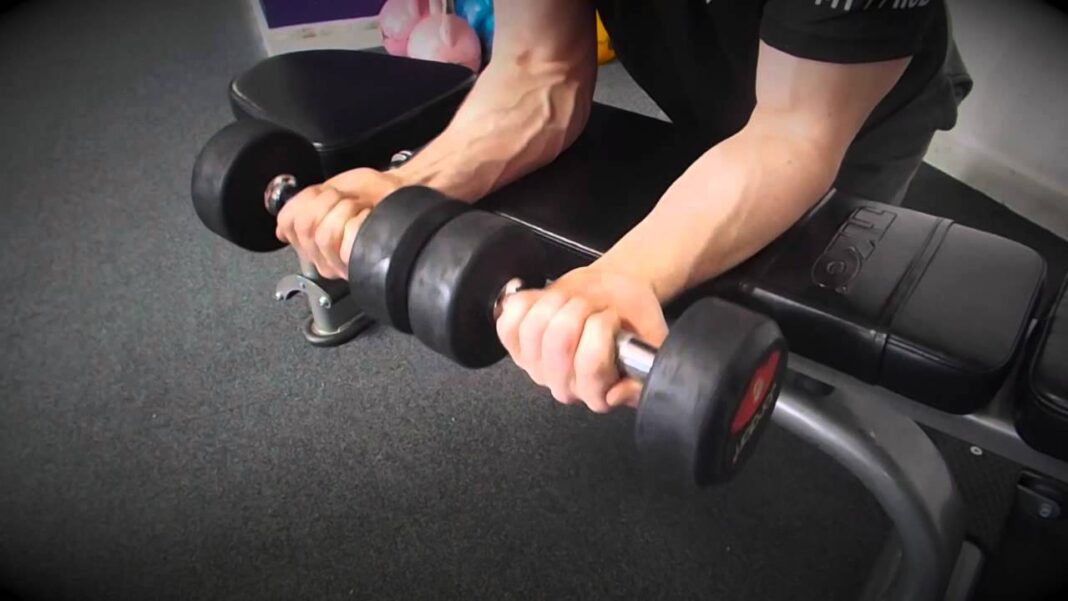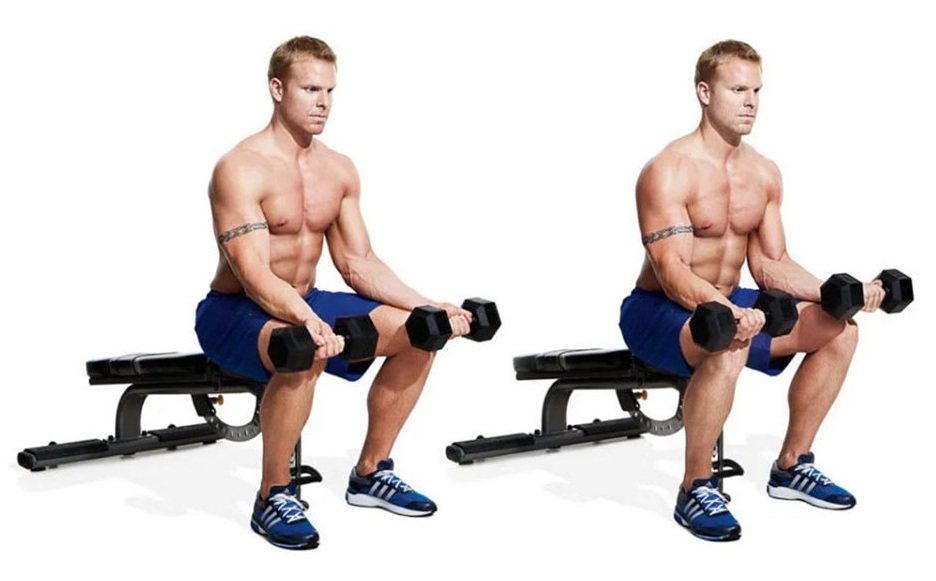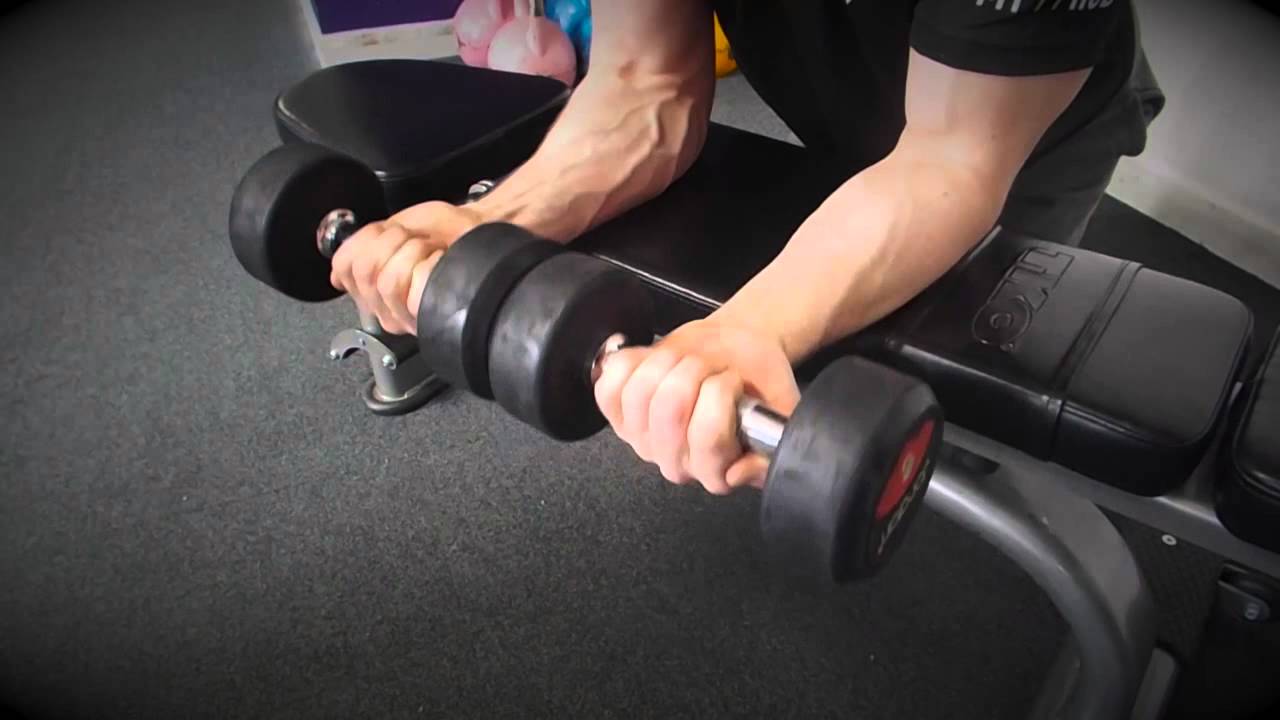Dumbbell Wrist Curl: Sculpting Forearm Size, Strength, and Symmetry
If you want complete arm development — not just big biceps and triceps, but that powerful, sinewy look from wrist to elbow — you can’t skip forearms.
And among all the isolation exercises for forearm flexors, few can match the Dumbbell Wrist Curl for precision, control, and muscular activation.
While the Barbell Wrist Curl builds mass and density, the dumbbell version lets you train each arm independently, improving balance, coordination, and the mind–muscle connection that’s crucial for sculpting detailed forearms. It’s simple, highly effective, and adaptable for lifters at any level — from beginner to IFBB pro.
For bodybuilders, the Dumbbell Wrist Curl is a refinement tool — perfect for carving the forearm flexors and boosting grip endurance.
It’s also a strength accessory, helping you hold heavier weights in rows, deadlifts, and pull-ups.
Whether your goal is hypertrophy, aesthetics, or functional strength, this movement earns a permanent place in your program.
Muscles Worked
Primary Muscles:
- Flexor carpi radialis
- Flexor carpi ulnaris
- Palmaris longus
- Flexor digitorum superficialis and profundus
Secondary Muscles:
- Brachioradialis (upper forearm stability)
- Pronator teres (forearm rotation and balance)
- Finger flexors (for grip control)
💡 Anatomical Insight:
The forearm flexors are responsible for curling your wrist and gripping the bar. They originate at the medial epicondyle of the humerus (inner elbow) and run down to the wrist and fingers. The stronger and thicker these muscles get, the more dense and vascular your forearms become.
Why Bodybuilders Use It
- Unilateral Focus
- Fixes imbalances between left and right forearms.
- Superior Mind–Muscle Connection
- One arm at a time allows you to feel every fiber contract and stretch.
- Improved Grip Strength
- Enhances your performance on heavy compound lifts.
- Forearm Aesthetics
- Builds lower arm fullness and vascularity for that “hard” look.
- Joint-Friendly
- Dumbbells allow natural wrist movement and reduce strain on elbows.
How to Perform the Dumbbell Wrist Curl
Setup
- Sit on a flat bench with a dumbbell in one hand, palm facing up.
- Rest your forearm on your thigh, with your wrist and hand extending slightly past your knee.
- Allow the dumbbell to roll down to your fingertips, stretching your forearm flexors.
- Keep your back straight and shoulders relaxed.
Execution
- Curl Up (Concentric Phase)
- Exhale as you curl the dumbbell upward, flexing your wrist.
- Focus on using only the wrist and forearm — your elbow and upper arm stay still.
- Squeeze the contraction at the top for one second.
- Lower Under Control (Eccentric Phase)
- Inhale as you slowly lower the dumbbell, letting it roll back toward your fingertips.
- Maintain control for 3 seconds, emphasizing the stretch at the bottom.
Form Cues
✅ Rest only your forearm on the thigh — let the wrist hang freely.
✅ Keep tension constant; never let the dumbbell rest in your palm.
✅ Focus on a slow, controlled motion — the eccentric stretch is where growth happens.
✅ Do not lift the forearm — isolate the wrist joint.
✅ Perform all reps with complete control, not momentum.
Common Mistakes and Fixes
| Mistake | Issue | Fix |
| Using too much weight | Breaks form and limits range of motion | Use lighter dumbbell, control tempo |
| Short range of motion | Reduces stretch and activation | Let dumbbell roll to fingertips fully |
| Jerking the dumbbell | Engages biceps and shoulders | Slow tempo, no assistance |
| Neglecting eccentric phase | Misses main growth driver | Lower over 2–3 seconds |
| Not training both sides equally | Causes imbalance | Alternate arms, equal reps and sets |
Programming for Growth and Definition
For Hypertrophy (Size)
- Sets: 3–4
- Reps: 12–20
- Tempo: 2 seconds up, 3 seconds down
- Rest: 45–60 seconds
For Strength
- Sets: 4–5
- Reps: 8–12
- Rest: 60–90 seconds
- Focus on heavier dumbbells with strict form.
For Definition / Endurance
- Sets: 3
- Reps: 20–25
- Rest: 30–45 seconds
- Prioritize continuous tension and a full range of motion.
Training Tips from a Bodybuilder’s Perspective
💪 Control Every Rep
The wrist curl is not about speed — it’s about precision and tension. Go slow, feel the squeeze.
💪 Stretch at the Bottom
Let the dumbbell roll into your fingers slightly to lengthen the flexors. This “loaded stretch” drives hypertrophy.
💪 Volume Beats Intensity
Forearms grow from frequency and volume, not max loads. Train them 2–3 times weekly.
💪 Add Grip Work
Combine dumbbell wrist curls with farmer’s holds or plate pinches for full functional forearm strength.
💪 Pair with Reverse Curls
Balance flexor training with extensor work to prevent tendon strain and maximize shape.
Variations
- Seated Both-Arms Dumbbell Wrist Curl
- Perform with both arms simultaneously for efficiency.
- Ideal for building overall forearm mass.
- Standing Dumbbell Wrist Curl
- Increases stability demands and grip engagement.
- Great variation for athletes and functional strength.
- Behind-the-Back Dumbbell Wrist Curl
- Unique angle emphasizing the lower flexors.
- Fantastic for advanced lifters chasing detail.
- Incline Dumbbell Wrist Curl
- Rest forearms on an incline bench for constant tension.
- Reduces shoulder involvement, pure isolation.
- Cable Wrist Curl (Single Handle)
- Constant resistance through the full range.
- Excellent for shaping and high-rep work.
Sample Forearm Workout (Flexor Focus)
- Dumbbell Wrist Curl: 4×15–20
- Reverse Barbell Wrist Curl: 3×15–20
- Hammer Curl: 3×12–15
- Farmer’s Carry: 3×30 seconds
💡 Tip: Perform this session at the end of your arm or back workout for maximum pump and endurance.
Advanced Training Strategies
- Superset: Dumbbell + Reverse Curl
- Alternate wrist curls and reverse curls with no rest.
- Trains both flexors and extensors for balanced development.
- Slow Negatives
- 4–5 second lowering phase — perfect for building density.
- Drop Sets
- Reduce dumbbell weight by 25% after failure, continue immediately.
- Isometric Holds
- Hold peak contraction for 3–5 seconds at the top of each rep.
- Enhances control and forearm hardness.
- 21s (Partial Reps)
- 7 bottom-half, 7 top-half, 7 full reps — nonstop burn.
Safety and Recovery Tips
⚠️ Don’t overload — light to moderate weight ensures joint safety.
⚠️ Keep wrists in their natural range, avoid hyperextension.
⚠️ Stretch forearms post-workout to maintain flexibility.
⚠️ Use neutral wrist angles if prone to tendon irritation.
⚠️ Include extensor work (reverse wrist curls) to prevent overuse injuries.
Bodybuilder Insights
- Arnold Schwarzenegger and Frank Zane performed wrist curls after every arm workout, chasing that marble-like forearm fullness.
- Dorian Yates emphasized slow eccentrics, focusing on stretch and control.
- Chris Bumstead often uses unilateral dumbbell wrist curls to enhance mind–muscle connection and even out forearm size before competition.
In short: pros don’t skip wrist curls — they refine them. It’s the fine-tuning work that builds the difference between strong arms and complete arms.
Strength vs Aesthetic Focus
| Goal | Style | Reps | Benefit |
| Strength | Moderate weight, strict tempo | 8–12 | Enhances grip strength and control |
| Mass | High volume, full range | 12–20 | Builds thick, dense flexors |
| Detail | Lighter weight, long tension time | 15–25 | Improves definition and vascularity |
Practical Takeaways
✅ Train each forearm separately for symmetry and balance.
✅ Focus on slow eccentrics and full stretch for best results.
✅ Perform wrist curls 2–3 times per week.
✅ Balance flexor work with extensor training.
✅ Keep weights moderate — control trumps ego.
Conclusion
The Dumbbell Wrist Curl is the definition of simple yet effective bodybuilding. It isolates the forearm flexors like nothing else, improves grip strength, and brings visible thickness and vascular detail to your lower arms.
By training each arm individually, you’ll correct imbalances, master control, and develop the kind of forearms that look carved from stone — balanced, full, and functional.
If you’re serious about complete arm development, treat your forearms with the same respect you give your biceps and triceps.
Curl. Stretch. Squeeze. Control.
That’s how great forearms are built.




